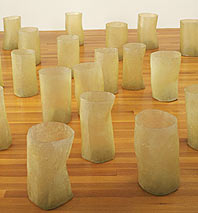
In 1968, the sculptor Eva Hesse (1936–1970) began a piece called Repetition Nineteen, a group of nineteen fiberglass “buckets.” She rejected the first buckets made by the fabricator because they all looked the same. Each, she said, must have a distinct character. And the grouping must be randomly arranged and not fixed into an orderly grid. This sort of challenge to traditional Minimal aesthetics is what’s typically emphasized about Hesse. It’s the easiest way to discuss her art. Her pigeonhole. She’s the seducer of the grid, the un-Judd, who uses Minimalist ideas but also brings into play the irregular, the messy, and the chaotic. What this academic approach can’t suggest—and photographs of her work can’t reveal—is the uncanny presence of her sculpture. Hesse is the most elusive artist of her generation. Her fiberglass buckets aren’t just fiberglass buckets. They’re almost alive.
“Eva Hesse: Sculpture,” organized by Fred Wasserman and Elisabeth Sussman for the Jewish Museum, focuses on the artist’s breakthrough exhibit at the Fischbach Gallery in 1968. It also includes a few pieces made before and after this show and, in the final room, a collection of biographical material. Hesse died young, of a brain tumor, and her life wasn’t easy. She came from a prosperous and observant Jewish family in Hamburg. They escaped from Germany just before World War II and settled in New York, where her mother, a manic-depressive, committed suicide. Her father, who found it difficult to adjust to the New World, was devoted to Eva and her sister Helen and during their childhood compiled picture-filled diaries of their early lives. Hesse loved these books, and she always made clear how vital her family history and life story were to her art.
As a young artist, Hesse revered de Kooning and Gorky, and her sensibility, like that of those artists, is rooted in line and a feeling for the tactile poetry of the body. (The Drawing Center, in conjunction with the Jewish Museum, is exhibiting a fine selection of Hesse’s drawings.) Her early work has a Surrealist spirit and is full of anthropomorphic forms that suggest body parts. But Hesse was also an ambitious artist in the Minimalist period, and her Surrealist-inspired art would have looked old-fashioned to many contemporaries. Her engagement with Minimalism, a style in many ways alien to her, put her under fruitful pressure—and led to original work. Like the Minimalists, she cleansed her art of obvious references to the body and excised romantic associations. In her work, she said, a circle “wasn’t a breast and it wasn’t a circle representing life and eternity. I think that’s [sic] … would be fake.” But her circle, she said, also wasn’t “geometric”— not, that is, an expression of Minimalist orthodoxy.Hesse liked to say she wanted an art close to “nothing,” by which she probably meant an art that could not be claimed by obvious, literal, or corny associations. At the same time, she often gave her sculptures poetic names and disliked calling them Untitled, so she wasn’t looking for something vacant or empty. And she always sought “absurdity,” a rich and full-bodied word with existential overtones in the postwar period. (Those fiberglass buckets could belong to Samuel Beckett.) She cultivated wrongness, mistakes, and surprise, hoping, like Zen artists, to make work that was unexpected and did not have the self-important air of high art. Like a good Minimalist, she chose to work with industrial materials, but her choice of latex and fiberglass was not a mechanical decision. Latex, in particular, has a fleshy quality, and both materials are suffused with light. In her art, Hesse created a fresh sensation of the body, at once earthy, clumsy, and light-filled.
It’s easy to endow Hesse’s abbreviated life with a sentimental aura. She wouldn’t have liked that. Her particular victory was to surmount the merely or quaintly personal. (She would have enjoyed T.S. Eliot’s wry observation that “only those who have personality and emotions know what it means to want to escape from these things.”) But separating her art from her life with too much severity can also become precious. Hesse’s brief oeuvre is now rapidly decaying, especially her latex sculptures. The image of brevity, in the art and the life, is now inescapable—and piercing.
Eva Hesse: Sculpture
Jewish Museum. Through September 17.